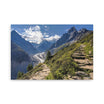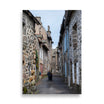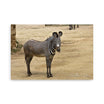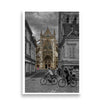Diving into Street Photography
Introduction
Street photography offers a unique window into the hustle and bustle of everyday life, transforming every corner into a scene full of life and unwritten stories. This visual art doesn’t just capture moments; it celebrates the unexpected and authenticity of human interaction, highlighting the spontaneous beauty that surrounds us that is often overlooked.
Developing Your Photographic Eye
Mastering street photography requires a good knowledge of your equipment and a keen sense of observation. Experienced photographers recommend using a wide-angle lens for full immersion in the environment and to capture the true essence of urban scenes with more context ( Shotkit ) ( Eric Kim Photography ) .
Developing your photographic eye in street photography is essential to capturing images that tell compelling stories and convey authentic emotions. Here are some key strategies to sharpen your perception and improve your photography skills:
1. Continuous Observation
Street photography requires a keen sense of observation. Spend time looking at people and environments without your camera. Learn to anticipate interesting interactions and moments before they happen. This practice will help you anticipate and be ready when the perfect moment presents itself.
2. Understanding Light
Light is a fundamental element in photography. Observe how light interacts with subjects and environments throughout the day. Notice how shadows and textures change, and how this affects the mood and feeling of a scene. Use these observations to choose the best time to shoot, harnessing natural light to create powerful images.
3. Regular Practice
Consistency is key. Get out there with your camera as often as possible. The more you practice, the more comfortable you will be with your equipment and the quicker you will be able to react. Every photography session is an opportunity to learn and discover new techniques and approaches.
4. Experimenting with Perspectives
Don’t settle for the usual angles. Try shooting from different heights and angles. Arrange to shoot from above, below, or find reflections to add depth to your images. Changing your perspective can transform an ordinary scene into an extraordinary image.
5. Analysis of Works
Study the work of great street photographers. Understand the choices they make for composition, timing, and visual storytelling. Sites like Magnum Photos or online platforms offer galleries of renowned photographers' work that can serve as inspiration and guidance.
6. Feedback and Criticism
Share your work with others and be open to feedback. Constructive criticism from other photographers or art lovers can give you new perspectives and improve your critical eye.
By developing your photographic eye, you will not only improve your technique but also your ability to capture the essence of street life, transforming fleeting moments into timeless images. Street photography is as much a technical skill as it is an art of seeing, requiring patience, passion and perseverance.
The Importance of Framework and Approach
Choosing the right frame is crucial: it can transform an ordinary scene into a captivating work. Interactions, contrasts and moments of pure authenticity are the jewels of this photographic genre. It is also important to remain discreet and respectful towards the subjects photographed to maintain the integrity of these natural moments ( Adobe ) ( Photography Life ) .
In street photography, choosing the right frame and approach is crucial to capturing the essence of fleeting moments while respecting the integrity of the subject and the environment. Here’s how these elements influence the quality and impact of your images:
1. Choice of Frame
The frame in street photography determines not only what the viewer sees, but also how they perceive the subject. Good framing can transform a mundane scene into a captivating composition by highlighting contrasts, symmetries, or interesting interactions between people and their surroundings. It is essential to practice visual composition by considering basic guidelines such as the rule of thirds, where the subject is positioned at a point that naturally draws the eye, creating visual balance.
2. Discreet Approach
Street photography often requires a discreet approach to capture moments authentically and without interference. Experienced street photographers often recommend using less intrusive equipment and blending into the environment so as not to disturb the natural flow of events. This allows for the capture of natural expressions and spontaneous interactions, which are often at the heart of the emotional impact of these images.
3. Interaction with the Subject
While discretion is important, interacting with subjects can sometimes enrich street photography. This interaction can be as simple as exchanging glances or smiling before taking a photo, which can help establish a level of comfort and openness. However, it is crucial to respect the person and their space, ensuring that subjects feel respected and safe.
4. Cultural Sensitivity
Understanding and respecting the cultural norms of the place you are photographing is essential. Every community has its own sensitivities, and what is acceptable in one culture may be considered intrusive or disrespectful in another. An ethical approach to street photography involves knowing and navigating these differences with sensitivity.
5. Responsiveness and Adaptability
The streets are dynamic, and scenes can change in an instant. Being responsive and able to adapt quickly is key to capturing moments that don’t repeat themselves. This could mean quickly changing positions, adjusting camera settings on the fly, or simply recognizing when a potentially captivating moment is about to happen.
The framework and approach in street photography is not limited to technique; it also encompasses ethics, empathy, and a deep understanding of humanity. Every decision the photographer makes contributes to the visual narrative of the scene and influences how the subject is perceived and understood by those who will view the image.
Creative Techniques and Composition
Techniques range from choosing black and white to accentuate contrast and depth, to using color to capture the energy and mood of a location. Photographers are encouraged to experiment with different angles and perspectives to reveal new dimensions in seemingly mundane scenes ( Adobe ) ( Photography Life ) .
Street photography is all about reflexes, preparation, and creativity. Here are some composition techniques and tips that can help you capture more expressive and impactful images.
1. Use of Natural Light
Natural light plays a crucial role in creating the mood of a photo. The golden hour, shortly after sunrise or before sunset, offers soft, flattering light that can dramatize any urban subject. Long shadows and strong contrasts during these hours can also add depth and mystery to your compositions.
2. Framing and Perspective
Changing your perspective can transform an ordinary scene into a captivating work of art. Try taking photos from unique vantage points: bending down to capture the cobblestones of a street or climbing up high to get a bird’s eye view. Using natural frames, like windows or arches, can also add visual interest and guide the viewer’s eye to the main subject.
3. The Principle of Frame Filling
Filling the frame with your subject can add visual impact to the photo. This means getting close enough that the subject’s details dominate the image, which is especially effective for capturing facial expressions or clothing details that tell a story.
4. Search for Patterns and Repetitions
Repeating patterns can add an element of surprise and interest to street photography. Looking for patterns in architecture, pavements, or even people's behaviors can give your photos a rhythmic and graphic dimension.
5. Interaction of Colors
Colors can be used to create harmony or contrast in your images. Using complementary colors or bold juxtapositions can help your subject stand out or evoke a particular mood. For example, a bright red wall behind a subject dressed in green can not only draw the eye but also heighten the energy of the scene.
6. Depth of Field
Playing with depth of field is a powerful technique in street photography. Using a shallow depth of field can isolate the subject from its surroundings, blurring the background while highlighting the subject’s details. Conversely, a deep depth of field can capture the entire scene with a clarity that helps situate the subject within a larger urban context.
By incorporating these techniques and approaches into your photography practice, you can not only improve the aesthetic quality of your images but also enrich the visual narrative of your street captures. Every photo tells a story, and mastering these compositional elements will help you tell that story in a more expressive and memorable way.
Connecting with the Subject
Proximity can play a big role in the impact of a street photograph. Getting up close not only allows you to capture intimate details, but also establishes a subtle connection with the subject, making the final image more powerful and personal ( Digital Photography School ) ( Photography Life ) .
Ethics and Responsibility
Ethics are essential in street photography. It is important to respect the lives and private spaces of the people being photographed, avoiding capturing individuals in vulnerable situations or without their consent. This respectful approach not only ensures respect for the subjects but also enriches the moral quality of your artistic work ( Photography Life ) .
Street photography, while artistic and expressive, carries a great deal of ethical responsibility. Understanding and respecting the individuals captured in the lens is crucial. Here are some key principles to consider when practicing street photography ethically and responsibly.
1. Consent and Respect
Privacy is fundamental in street photography. Even in public spaces, it’s important to respect the people you’re photographing. This may mean getting their consent, especially if the photo is taken up close or in a potentially sensitive context. If someone asks you not to photograph them or to delete a photo, it’s ethical to respect their request.
2. Impact on Subjects
Consider the impact of your photos on the subjects you photograph. Images can sometimes place subjects in unwanted light or expose them to unintended risks, especially in vulnerable contexts. Be aware of these implications and evaluate whether posting certain images could harm your subjects.
3. Cultural Sensitivity
When photographing in culturally diverse environments, it is essential to understand and respect local cultural norms. This respect may include ways of dressing, religious practices, or attitudes toward photography. Being aware of and sensitive to these issues can help prevent uncomfortable or conflicting situations.
4. Honesty and Integrity
Present your subjects with honesty and integrity. This means avoiding manipulating images in ways that mislead the viewer or distort reality. Transparency about what was captured and how it is presented is essential to maintaining public trust in your work.
5. Positive Contribution
Think about how your images can contribute positively to society. Street photography has the power to raise awareness about important social issues, reveal beauty in the ordinary, and share unique perspectives. Use this medium to add value to the community rather than exploit or stigmatize.
6. Continuous Development
As a photographer, it is important to continue learning and developing yourself, not only technically, but also in terms of ethical awareness. Participating in workshops, seminars and discussions on ethics in photography can strengthen your understanding and ethical practice in this dynamic field.
By adopting an ethical and responsible approach, street photographers can not only respect their subjects and their environment, but also enrich their artistic practice. Street photography, practiced with awareness, can transform the way we see and interact with the world around us.
Conclusion
Street photography is more than just a technique; it is an exploration of the human condition through the lens of a camera. Every image tells a story, every frame captures a moment that will never be repeated. For those ready to embrace this art form, the streets offer an endless theater of visual narratives. Let your creativity and sensitivity guide your camera to discover and share the poetry hidden in the streets of the world.
This article serves as a guide for those who wish to explore and excel in street photography, offering advice on techniques, ethical approach, and how to capture the fleeting but meaningful moments that characterize urban life.





































































Leave a comment
All comments are moderated before being published.
This site is protected by hCaptcha and the hCaptcha Privacy Policy and Terms of Service apply.